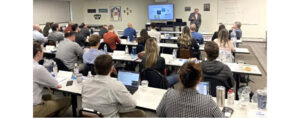
Steven E. Schillinger is a P.E. and PBE consultant in addition to being “actively retired.” He can be reached at schillingersteven@gmail.com and linkedin.com/in/seschillinger.
The vehicle service and repair industry will be reset to a new normal which, going forward in a post-pandemic era, will be continuously redefined and redesigned
Despite the Covid-19 crisis and the looming economic recession, the driver assistance market worldwide will grow by a projected $54.5 billion. An unusual period in history, the coronavirus pandemic has unleashed a series of unprecedented events affecting every industry.

The vehicle service and repair industry will be reset to a new normal which, going forward in a post-pandemic era, will be continuously redefined and redesigned. Staying on top of trends and accurate analysis is paramount now more than ever to manage uncertainty, change and adjustment to new and evolving market conditions.
Advanced Driver Assistance Systems (ADAS) keep drivers, passengers, and pedestrians safe. Most consumers that shop for a new or used car do not know that there are many different names for driver assistance technologies.
Many vehicle manufacturers are helping consumers break through the confusion with information about how these technologies work, as well as safety-related performance data. Some systems are designed to warn if you are at risk of a crash, while others are designed to actively avoid a crash.
Vehicle technologies and repair are advancing at an almost unprecedented rate. Recently, chairman and CEO of General Motors Mary Barra wrote: “The auto industry will change more in the next five to 10 years than it has in the past 50.” As Barra noted, the next step-change for the advancement of ADAS technologies will be the advent of the so-called connected car, made possible by the widespread adoption of vehicle-to-vehicle (V2V), vehicle-to-infrastructure (V2I) and vehicle-to-everything (V2X) communications.
An online survey of more than 900 participants conducted by State Farm found that while 70-95 percent of respondents had at least heard of the most common advanced technologies available in today’s vehicles, more than 60 percent reported having limited to no knowledge regarding them.
Frank Terlep, co-founder at Auto Techcelerators and a longtime collision repair industry expert, stated, “Effective deployment of these systems will require a national, ongoing communication campaign, that should include: 1) Information and data for fleets to implement ADAS, and, 2) Educational information for drivers and education and training for maintenance and repair personnel that are tasked to inspect, repair, troubleshoot and maintain ADAS equipped vehicles.”
From blind-spot detection and braking systems to the connected car and autonomous vehicles, some of the latest technology pros and cons are listed below.
THE PROS:
- Increased passenger convenience and productivity encourages people to travel more.
- Reduced vehicle operating costs (due to electrification) increases vehicle travel.
- Managing traffic flow to increase road capacity, i.e., number of vehicles on the road.
- Users can choose vehicles that best meet their needs. Door to door service.
- Reduced driver stress and increased productivity. Motorists can rest, play, and work while traveling.
- Increased safety. May reduce crash risks and insurance costs. May reduce high-risk driving.
- Reduced parking costs. Reduces demand for parking at destinations.
- Reduced energy consumption and pollution. May increase fuel efficiency and reduce emissions.
THE CONS:
- Potential for the new technology to go wrong.
- Potential loss of privacy.
- Users must wait for vehicles. Limited services (no driver to help passengers carry luggage or ensure safety).
- Reduced security and confidentiality. May be vulnerable to information abuse (hacking), and features such as location tracking and data sharing may reduce privacy.
- Increased infrastructure costs. May require higher roadway design and maintenance standards.
- May increase risks to other road users and may be used for criminal activities.
- Adaptive cruise control can lead to excessive breaking and acceleration, which is bad for street capacity usage and fuel consumption.
- Some early studies of accident statistics involving Automatic Braking Systems (ABS) concluded the risk of single-vehicle accidents involving the car leaving the road actually increased. A study by the American National Highway Traffic Safety Administration (NHTSA) found a 28 percent increase in fatal run-off-road rollover crashes in vehicles with ABS.
IN CONCLUSION
Global shipments of new light vehicles are projected grow from nearly 90 million in 2019 to 120 million by 2025, according to industry estimates. Sensors for driver assistance are essential components in the feedback loop of any ADAS system.
While current cars average 80-100 onboard sensors, this number is projected to more than double as cars become increasingly “smart” and connected. This translates to a projected 24 billion onboard sensors used in vehicles by 2025.
Driver assistance systems have developed and become available on the market with such speed that many fleet drivers, operators, dealers, and insurers are left with challenges surrounding implementation — which options to choose from, training and how far they may go to limit risk is yet to be determined.






Comments are closed.